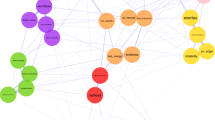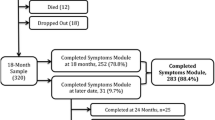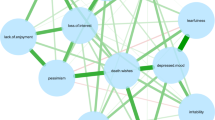Abstract
Housing insecurity is associated with co-occurring depression and pain interfering with daily activities. Network analysis of depressive symptoms along with associated risk or protective exposures may identify potential targets for intervention in patients with co-occurring bodily pain. In a community-based sample of adults (n = 408) living in precarious housing or homelessness in Vancouver, Canada, depressive symptoms were measured by the Beck Depression Inventory; bodily pain and impact were assessed with the 36-item Short Form Health Survey. Network and bootstrap permutation analyses were used to compare depressive symptoms endorsed by Low versus Moderate-to-Severe (Mod + Pain) groups. Multilayer networks estimated the effects of risk and protective factors. The overall sample was comprised of 78% men, mean age 40.7 years, with 53% opioid use disorder and 14% major depressive disorder. The Mod + Pain group was characterized by multiple types of pain, more persistent pain, more severe depressive symptoms and a higher rate of suicidal ideation. Global network connectivity did not differ between the two pain groups. Suicidal ideation was a network hub only in the Mod + Pain group, with high centrality and a direct association with exposure to lifetime trauma. Antidepressant medications had limited impact on suicidal ideation. Guilt and increased feelings of failure represented symptoms from two other communities of network nodes, and completed the shortest pathway from trauma exposure through suicidal ideation, to the non-prescribed opioid exposure node. Interventions targeting these risk factors and symptoms could affect the progression of depression among precariously housed patients.




Similar content being viewed by others
References
Vogel M, Frank A, Choi F et al (2017) Chronic pain among homeless persons with mental illness. Pain Med (United States) 18:2280–2288
Gutwinski S, Schreiter S, Deutscher K, Fazel S (2021) The prevalence of mental disorders among homeless people in high-income countries: an updated systematic review and meta-regression analysis. PLoS Med 18:e1003750
IsHak WW, Wen RY, Naghdechi L et al (2018) Pain and depression: a systematic review. Harv Rev Psychiatry 26:352–363
Fond G, Tinland A, Boucekine M et al (2019) The need to improve detection and treatment of physical pain of homeless people with schizophrenia and bipolar disorders. Results from the French housing first study. Prog Neuropsychopharmacol Biol Psychiatry 88:175–180
Moussavi S, Chatterji S, Verdes E et al (2007) Depression, chronic diseases, and decrements in health: results from the world health surveys. Lancet 370:851–858
Jones AA, Cho LL, Kim DD et al (2022) Pain, opioid use, depressive symptoms, and mortality in adults living in precarious housing or homelessness. Pain 163(11):2213–2223
Ayano G, Tsegay L, Abraha M, Yohannes K (2019) Suicidal ideation and attempt among homeless people: a systematic review and meta-analysis. Psychiatry Q 90:829–842
Sansone RA, Sansone LA (2008) Pain, pain, go away: antidepressants and pain management. Psychiatry (Edgmont) 5:16–19
Fried EI, Nesse RM, Zivin K et al (2013) Depression is more than the sum score of its parts: Individual DSM symptoms have different risk factors. Psychol Med 44(10):2067–2076
Contreras A, Nieto I, Valiente C et al (2019) The study of psychopathology from the network analysis perspective: a systematic review. Psychother Psychosom 88:71–83
Buckman J, Cohen Z, O’Driscoll C et al (2021) Predicting prognosis for adults with depression using individual symptom data: a comparison of modelling approaches. Psychol Med 53(2):1–11
Opsahl T, Agneessens F, Skvoretz J (2010) Node centrality in weighted networks: generalizing degree and shortest paths. Soc Netw 32:245–251
Borsboom D (2017) A network theory of mental disorders. World Psychiatry 16:5–13
Borsboom D, Deserno MK, Rhemtulla M et al (2021) Network analysis of multivariate data in psychological science. Nat Rev Methods Primers 1:58
Beard C, Millner AJ, Forgeard MJC et al (2016) Network analysis of depression and anxiety symptom relationships in a psychiatric sample. Psychol Med 46:3359–3369
Fried EI, Von Stockert S, Haslbeck JMB et al (2020) Using network analysis to examine links between individual depressive symptoms, inflammatory markers, and covariates. Psychol Med 50:2682–2690
McWilliams LA, Sarty G, Kowal J, Wilson KG (2017) A network analysis of depressive symptoms in individuals seeking treatment for chronic pain. Clin J Pain 33:899–904
Cramer AOJ, Borsboom D, Aggen S, Kendler K (2012) The pathoplasticity of dysphoric episodes: differential impact of stressful life events on the pattern of depressive symptom inter-correlations. Psychol Med 42:957–965
Vila-Rodriguez F, Panenka WJ, Lang DJ et al (2013) The hotel study: multimorbidity in a community sample living in marginal housing. Am J Psychiatry 170:1413–1422
Gaetz S, Barr C, Friesen A et al (2012) Canadian definition of homelessness. Canadian Observatory on Homelessness Press, Toronto
Saris-Baglama RN, Dewey CJ, Chrisholm GB, et al (2009) Quality metric health outcomes scoring software 3.0: user’s guide.
Hopman WM, Towheed T, Anastassiades T et al (2000) Canadian normative data for the SF-36 health survey. Can Med Assoc J 163:265–271
Marsden J, Gossop M, Stewart D et al (1998) The Maudsley addiction profile (MAP): a brief instrument for assessing treatment outcome. Addiction 93:1857–1867
Beck AT, Ward CH, Mendelson M, Mock J (1961) An inventory for measuring depression. Arch Gen Psychiatry 4:561–571
Cho LL, Jones AA, Barbic S et al (2021) Psychometric properties and correlates of the beck depression Inventory in a community-based and homeless or precariously housed sample. J Affect Disord Rep 6:100229
Charlson ME, Pompei P, Ales KL, MacKenzie CR (1987) A new method of classifying prognostic comorbidity in longitudinal studies: development and validation. J Chronic Dis 40:373–383
Sobell LC, Agrawal S, Sobell MB et al (2003) Comparison of a quick drinking screen with the timeline followback for individuals with alcohol problems. J Stud Alcohol 64:858–861
Jones AA, Vila-Rodriguez F, Panenka WJ et al (2013) Personalized risk assessment of drug-related harm is associated with health outcomes. PLoS ONE 8(11):e79754
Jones AA, Gicas KM, Seyedin S et al (2020) Associations of substance use, psychosis, and mortality among people living in precarious housing or homelessness: a longitudinal, community-based study in Vancouver, Canada. PLOS Med 17:e1003172
Yuan Z, Chen Z, Xue M et al (2020) Application of antidepressants in depression: a systematic review and meta-analysis. J Clin Neurosci 80:169–181
Rosenbaum JF, Zajecka J (1997) Clinical management of antidepressant discontinuation. J Clin Psychiatry 58(Suppl 7):37–40
Mueser K, Salyers M, Rosenberg S et al (2001) Psychometric evaluation of trauma and posttraumatic stress disorder assessments in persons with severe mental illness. Psychol Assess 13:110–117
Jones AA, Jang K, Panenka WJ et al (2018) Rapid change in fentanyl prevalence in a community-based, high-risk sample. JAMA Psychiat 75:298–300
Lei M, Rintoul K, Stubbs JL et al (2021) Characterization of bodily pain and use of both prescription and non-prescription opioids in tenants of precarious housing. Subst Use Misuse 56:1951–1961
Honer WG, Cervantes-Larios A, Jones AA et al (2017) The Hotel study - clinical and health service effectiveness in a cohort of homeless or marginally housed persons. Can J Psychiat 62:482–492
Friedman J, Hastie T, Tibshirani R (2008) Sparse inverse covariance estimation with the graphical lasso. Biostatistics 9:432–441
Foygel R, Drton M (2010) Extended bayesian information criteria for gaussian graphical models. Adv Neural Inf Process Syst 23:604–612
Epskamp S, Waldorp LJ, Mõttus R, Borsboom D (2018) The Gaussian graphical model in cross-sectional and time-series data. Multivar Behav Res 53:453–480
Robinaugh DJ, Millner AJ, McNally RJ (2016) Identifying highly influential nodes in the complicated grief network. J Abnorm Psychol 125:747–757
Pons P, Latapy M (2006) Computing communities in large networks using random walks. J Graph Algorithms Appl 10:191–218
Van Borkulo C, Boschloo L, Borsboom D et al (2015) Association of symptom network structure with the course of longitudinal depression. JAMA Psychiat 72:1219–1226
Hinze V, Ford T, Crane C et al (2021) Does depression moderate the relationship between pain and suicidality in adolescence? A moderated network analysis. J Affect Disord 292:667–677
Coohey C, Easton SD, Kong J, Bockenstedt JKW (2015) Sources of psychological pain and suicidal thoughts among homeless adults. Suicide Life-Threat Behav 45:271–280
Maremmani AGI, Bacciardi S, Somers JM et al (2018) Substance dependence among bipolar, unipolar depression and psychotic homeless: a Canadian national study. Front Psych 9:701
Hah JM, Mackey S, Barelka PL et al (2014) Self-loathing aspects of depression reduce postoperative opioid cessation rate. Pain Med (Malden, Mass) 15:954–964
Corrigan FM, Fisher JJ, Nutt DJ (2011) Autonomic dysregulation and the window of tolerance model of the effects of complex emotional trauma. J Psychopharmacol 25:17–25
Tondo L, Vázquez GH, Baldessarini RJ (2020) Melancholic versus nonmelancholic major depression compared. J Affect Disord 266:760–765
Ohayon MM, Schatzberg AF (2002) Prevalence of depressive episodes with psychotic features in the general population. Am J Psychiatry 159:1855–1861
Held P, Owens GP (2015) Effects of self-compassion workbook training on trauma-related guilt in a sample of homeless veterans: a pilot study. J Clin Psychol 71:513–526
Jego M, Abcaya J, Ştefan DE et al (2018) Improving health care management in primary care for homeless people: a literature review. Int J Environ Res Public Health 15(2):309–329
Acknowledgements
We thank the Hotel Study research assistants and volunteers. We are grateful for the individuals that participate in this study.
Funding
This work was supported by the Canadian Institutes of Health Research (MOP-137103).
Author information
Authors and Affiliations
Corresponding author
Ethics declarations
Conflict of interest
AAJ, LLC, KMG, OL, JLS, TB, AET, DJL, GWM, WJP, AMB, and TSF report no conflicts of interest. RMP has received consulting fees or sat on paid advisory boards for Janssen, Lundbeck, and Otsuka; and is on the speaker’s bureau for Janssen, Lundbeck, and Otsuka. FVR receives research support from CIHR, Brain Canada, Michael Smith Foundation for Health Research, Vancouver Coastal Health Research Institute, and Weston Brain Institute for investigator-initiated research. Philanthropic support from Seedlings Foundation. FVR has also received in-kind equipment support for this investigator-initiated trial from MagVenture and honoraria for participation in advisory board for Janssen. WGH has received consulting fees or sat on paid advisory boards for: In Silico (unpaid), Translational Life Sciences (TLS), Newron and AbbVie.
Ethical approval
The authors assert that all procedures contributing to this work comply with the ethical standards of the University of British Columbia Clinical Research Ethics Boards and the Helsinki Declaration of 1975 as revised in 2008. Ethics approval certificate H08-00521. Written informed consent was obtained from participants to participate in the study.
Supplementary Information
Below is the link to the electronic supplementary material.
Rights and permissions
Springer Nature or its licensor (e.g. a society or other partner) holds exclusive rights to this article under a publishing agreement with the author(s) or other rightsholder(s); author self-archiving of the accepted manuscript version of this article is solely governed by the terms of such publishing agreement and applicable law.
About this article
Cite this article
Jones, A.A., Cho, L.L., Gicas, K.M. et al. Multilayer depressive symptom networks in adults with bodily pain living in precarious housing or homelessness. Eur Arch Psychiatry Clin Neurosci 274, 643–653 (2024). https://doi.org/10.1007/s00406-023-01664-0
Received:
Accepted:
Published:
Issue Date:
DOI: https://doi.org/10.1007/s00406-023-01664-0




